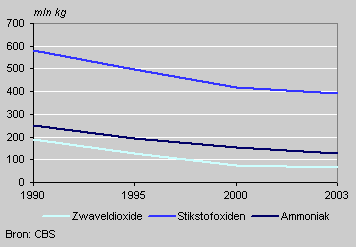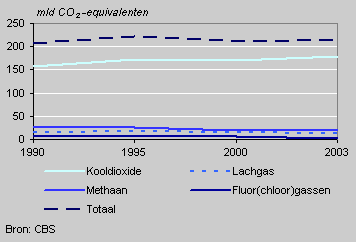Emission of pollutants continues to fall

Emissions of sulphur dioxide, nitrogen oxides and ammonia into the Dutch atmosphere were lower in 2003 than in 2002. The emission of the greenhouse gas carbon dioxide continued to increase however.
The emission of sulphur dioxide amounted to 66 million kilos in 2003, 1.3 percent less than in 2002. The decrease was caused by a decrease in industrial emissions. Some 391 million kilos of nitrogen oxides were released into the air in 2003, 1.7 percent less than in the previous year. This reduction was mainly the result of the use of catalytic converters in road traffic. These figures exclude emission by shipping (in 2003: 73 million kilos of SO2 and 126 million kilos of NOx).
The emission of ammonia fell from 136 million kilos in 2002 to 128 million kilos in 2003, the outcome of lower manure production in agriculture.
Emission of pollutants

Both sulphur dioxide and nitrogen oxides emissions are well above the target levels for 2010. For ammonia this level was already realised in 2003.
Emission of CO2 continues to increase
The emission of carbon dioxide (CO2) continued to increase in 2003. The reduction in the emission of other greenhouse gases pushed up the share of carbon dioxide in the total emission of greenhouse gases in terms of CO2 equivalents, from 76 percent in 1990 to 84 percent in 2003. The emission of greenhouse gases in 2003 amounted to 214 billion CO2 equivalents.
Emission of greenhouse gases

High fuel use
Carbon dioxide emissions on the basis of the Kyoto protocol amounted to 179 billion kilos in 2003, 1.7 percent more than in 2002. One reason for the increase was the higher fuel use by households because 2003 was colder than 2002. Another reason was the higher fuel use by electricity plants, refineries and road traffic.
Sharp drop in emission of other greenhouse gases
The emission of laughing gas in 2003 was 43 million kilos, 3.4 percent down on 2002. This decrease mainly came about through a reduced emission in agriculture, as less manure was spread on farmland.
The decrease in cattle numbers resulted in a decrease in the total emission of methane by 2 percent in 2003. The emission of fluoride gases fell from 3.2 billion to 2.5 billion CO2 equivalents in 2003.
Ed Zonneveld